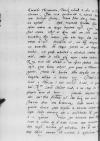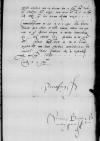List #2340
Seweryn BONER do Ioannes DANTISCUSCracow (Kraków), 1540-09-04
| odebrano Schmolainen (Smolajny), 1540-09-24 Rękopiśmienne podstawy źródłowe:
| ||||
Tekst + aparat krytyczny + komentarz Zwykły tekst Tekst + komentarz Tekst + aparat krytyczny
Reverendissimo in Christo Patri et Domino, domino
Reverendissime in Christo Pater et Domine, domine observandissime.
Salutem et perofficiosam meorum servitiorum commendationem.
Nactus hanc mittendi istuc occasionem, facere nolui, quin meas ad Reverendissimam Dominationem Vestram darem, quibus cum Reverendissimam Dominationem Vestram pro mea perpetua observantia salutarem, tum significarem illi eius me accepisse litteras, humanitatis et non ignotae mihi illius erga me benevolentiae plenas, de quibus, simul et de epigrammatis apologeticis mihi missis, magnas Reverendissimae Dominationi Vestrae habeo gratias, quamquam iam antea
Facerem equidem pro mea consuetudine non solum libenter, verum etiam pluribus verbis diligenter, ut, si quid novi hic esset, perscribere id Reverendissimae Dominationi Vestrae non negligerem. Verum est nunc quidem in hoc genere nihil, quod a me illi scribi oportere, magnopere existimarem. Nam quid in
Sed nec illud iam ignorat serenissimum
Ung(arorum) or Ungar(iae)⌈Ung(arorum)Ung(arorum) or Ungar(iae)⌉
 BCz, 1597, p. 1112 monacho thesaurario,
BCz, 1597, p. 1112 monacho thesaurario,
Conventus
 BCz, 1597, p. 1113 pulchre considisse cum ex aliorum, tum ex reverendissimi domini
BCz, 1597, p. 1113 pulchre considisse cum ex aliorum, tum ex reverendissimi domini
Commendatissimum me esse Reverendissimae Dominationi Vestrae cupio, cuius benevolentiam quia facio, ut debeo, maximi, daturus sum operam, ne quid officiosi obsequii in tuenda demerendaque illa cuiquam faciam reliqui, quantum in me certe erit. Precor Dominum Deum, ut Reverendissimam Dominationem Vestram sospitem et omni bona fortuna cumulatissimam diu conservet.
Dat(ae) or Dat(um)⌈Dat(ae)Dat(ae) or Dat(um)⌉
Eiusdem Dominationis Vestrae Reverendissimae paratissimus servitor



